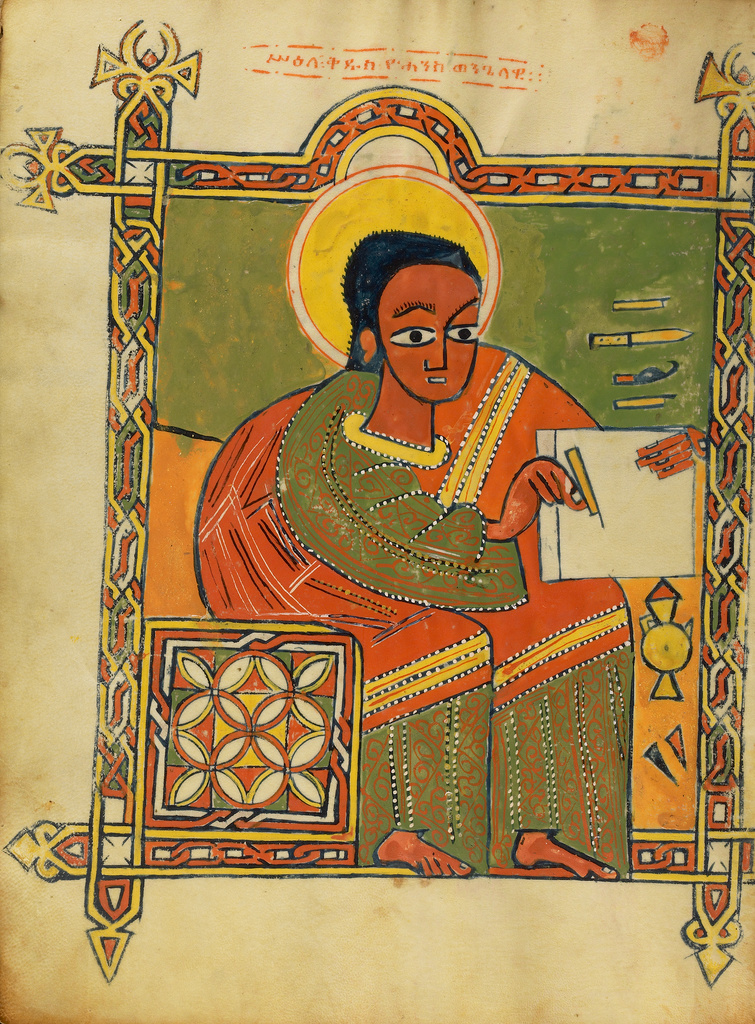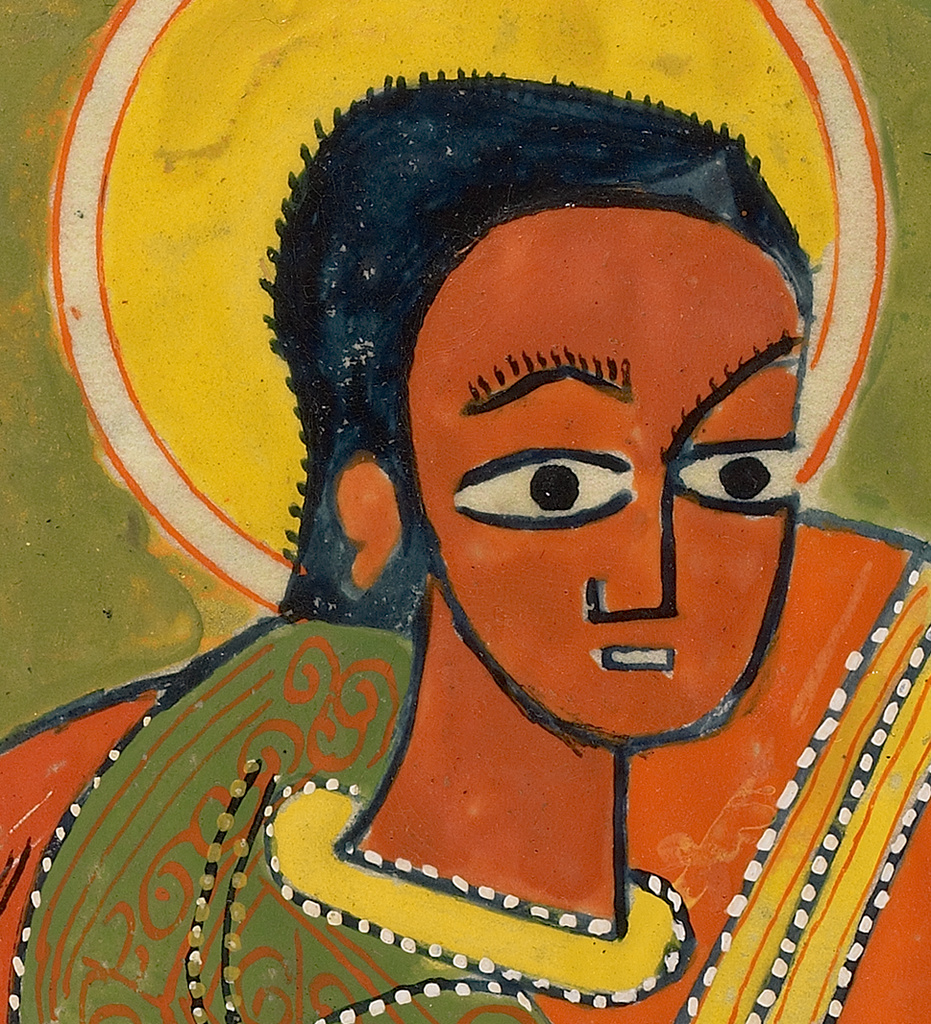The J. Paul Getty Museum
Collections Search
Gospel Book

Main Image
Open Content images tend to be large in file-size. To avoid potential data charges from your carrier, we recommend making sure your device is connected to a Wi-Fi network before downloading.
Not currently on view
Object Details
Title:
Gospel Book
Artist/Maker:
Unknown
Culture:
Ethiopian
Place:
Ethiopia (Place Created)
Date:
about 1504–1505
Medium:
Tempera on parchment
Object Number:
Ms. 102
Dimensions:
Leaf: 34.5 × 26.5 cm (13 9/16 × 10 7/16 in.)
Inscription(s):
Colophon, said to be original, inserted after the end of the Gospel of Mark [f. 142]: "This book was finished on the 29th day after the new moon, on the 14th day, in the days of the king Na'od, in the days of our bishop Abba Marqos, in the Year of Mercy 157. And as for me, the scribe, may [God] write his name on a pillar of gold. For ever and ever, Amen and Amen." The date according to the Ethiopian calendar belonged to late 1504 or early 1505 on our calendar.
Endnote in Amharic, Late 19th century hand, giving an account of the settlement in a murder case [fols. 268v-269].
Department:
Manuscripts
Classification:
Manuscripts
Object Type:
Manuscript
Alternate Numbers:
2008.15 (Object Number)
This Gospel book comes from the Christian kingdom of Ethiopia and is illuminated in the distinctive and profoundly expressive style that characterizes Ethiopian painting. Ethiopia was one of the earliest centers of Christianity. Over the course of the Middle Ages, this culture produced icons, processional crosses, and illuminated manuscripts that formed an integral part of its religious services. The manuscript is written in Ge'ez, the language of early Christian Ethiopia, which was by the10th and 11th centuries a primarily literary and liturgical language.
Dating between 1504 and 1505, this manuscript begins with an intricately decorated headpiece, called a haräg (from the Ge'ez word for tendril). It continues with a striking image of the Virgin and Child and eight canon table pages. Four evangelist portraits are remarkable for their monumentality and arresting palette of olive, orange, yellow, and white. The uniformly bright hues and rhythmic distribution of circular motifs and interlace create a vibrant, unified design throughout the manuscript.
This striking manuscript is illuminated in the so-called Gunda Gundé style. It takes its name from the location of the Stephanite monastery of Dabra Garzen, which possesses a number of examples of this type. The large, exaggeratedly rounded backs of the evangelists, their almond-shaped eyes and the dotted motif employed in their clothing are hallmarks of the Gunda Gundé style, which is characterized by an extreme stylization of the figures and geometric regularity.
Related Works
Exhibitions
Faces of Power and Piety: Portraiture in the Middle Ages and Renaissance (August 12 to October 26, 2008) (fols. 215v - 216)
- The J. Paul Getty Museum at the Getty Center (Los Angeles), August 12 to October 26, 2008
The Medieval Scriptorium (November 24, 2009 to February 14, 2010) (fols. 19v - 20)
- The J. Paul Getty Museum at the Getty Center (Los Angeles), November 24, 2009 to February 14, 2010
Building the Medieval World: Architecture in Illuminated Manuscripts (March 2 to May 16, 2010) (fols. 21v - 22)
- The J. Paul Getty Museum at the Getty Center (Los Angeles), March 2 to May 16, 2010
"In the Beginning was the Word": Medieval Gospel Illumination (August 30 to November 27, 2011) (fols. 26v - 27)
- The J. Paul Getty Museum at the Getty Center (Los Angeles), August 30 to November 27, 2011
Heaven and Earth: Byzantine Illumination at the Cultural Crossroads (March 25 to June 22, 2014) (fols. 19v - 20)
- The J. Paul Getty Museum at the Getty Center (Los Angeles), March 25 to June 22, 2014
Traversing the Globe through Illuminated Manuscripts (January 22 to June 26, 2016) (fols. 19v - 20)
- The J. Paul Getty Museum at the Getty Center (Los Angeles), January 22 to June 26, 2016
The Alchemy of Color in Medieval Manuscripts (October 11, 2016 to January 1, 2017) (fols. 215v - 216)
- The J. Paul Getty Museum at the Getty Center (Los Angeles), October 11, 2016 to January 1, 2017
Bibliography
Mercier, Jacques. Art that Heals: the Image as Medicine in Ethiopia, exh. cat. (New York: Prestel; The Museum for African Art, 1997), pp. 82-83, no. 37, fig. 85.
Mercier, Jacques. Vierges d'Éthiopie (Montpellier: L'Archange Minotaure, 2004), pp. 100-101, ill.
Fogg, Sam. Art of the Middle Ages (London: Sam Fogg, 2007), pp. 134-39, no. 41, ill.
Sciacca, Christine. Building the Medieval World (Los Angeles: J. Paul Getty Museum; London: The British Library, 2010), pp. 2, 83, fig. 81.
Keene, Bryan. "Il Medioevo Globale: Visioni del Mondo al Getty Museum." Alumina 14, no. 52 (January-March 2016), p. 51, cover ill.
Keene, Bryan C. "Il Medioevo Globale: Visioni del Mondo al Getty Museum." Alumina: Pagine Miniate 14, no. 52 (January - March 2016), 46-51, p. 51, ill.

